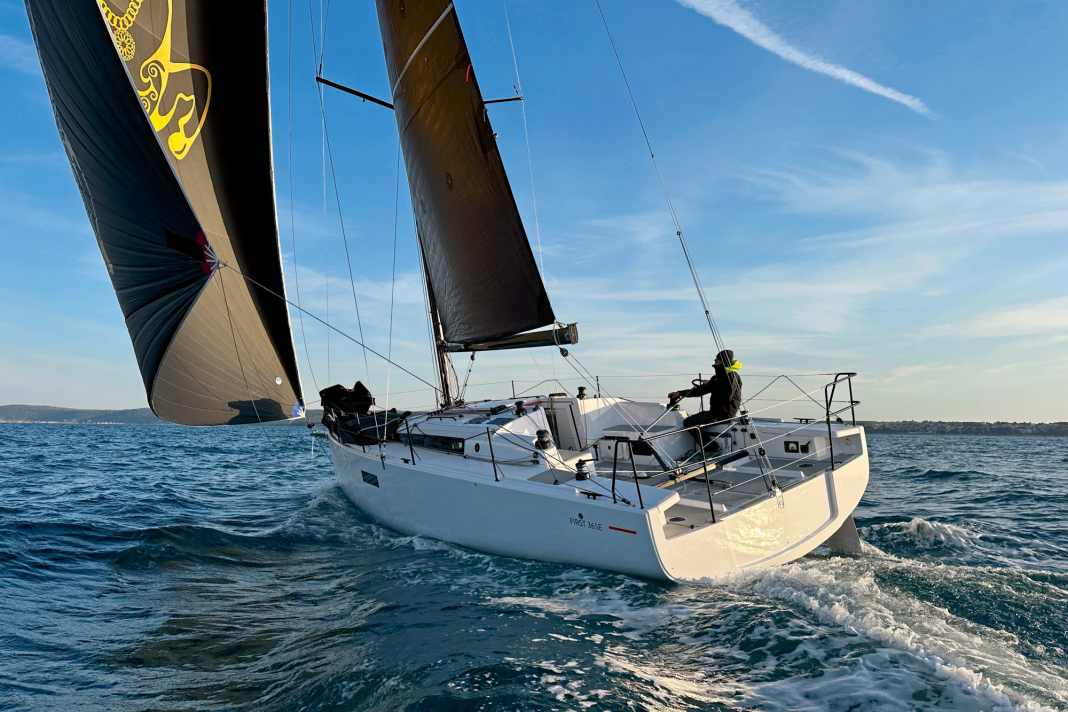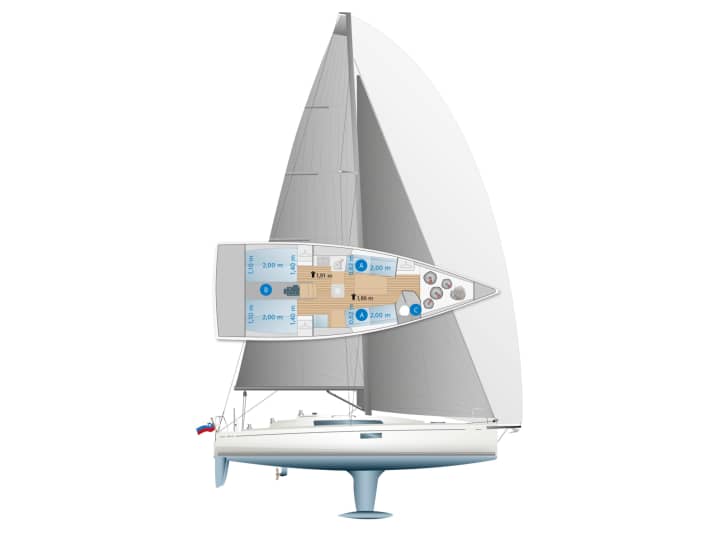





Great success for a small boat: in this year's Transpacific Yacht Race (Transpac), a production yacht just 36 feet (eleven metres) long crossed the finish line off Hawaii in second place. After travelling more than 2,200 nautical miles from Los Angeles to Honolulu, the Beneteau First 36 SE named "Rahan" was only beaten by the 88-foot maxi yacht "Lucky" (ex "Rambler 88"). Even though the large ships are only sent out later in the Transpac, the strong performance of the "Rahan" is still worth mentioning. Not only was she by far the smallest boat in the field of over 50 participating yachts, she was also the only boat to be sailed double-handed.
The First 36 from Beneteau is not a new boat. YACHT had already tested the racy Frenchwoman extensively when she was launched in 2022. And the boat had to be in the big comparison test of performance cruisers with a hull length of eleven metres against strong competition and was able to score points above all with its sailing characteristics on the centreboard.
More from the shipyard:
- Beneteau First 24 SE: Small cruiser with excessive sailing potential in the test
- YACHT test: What makes the Beneteau First 27 a successful model
- Beneteau First 30: A gliding yacht with cruising qualities in the YACHT test
- Beneteau First 44 - boat with broad appeal
- Beneteau First 53 on test: nippy cruising boat with superyacht characteristics
Like all smaller models in Beneteau's sporty First series, the 36 is also manufactured by Seascape. The Slovenian shipyard has been working as a partner and licensee for the French industry giant since 2018 and is not only responsible for production, but also for the development, line construction and marketing of boats up to eleven metres in hull length. And business is booming: with around 120 employees, Seascape now produces around 150 boats per year, from 14 to 36 feet.
Under the name Seascape Edition (SE), the Slovenians want to further expand their range and also give the boats in the First series an independent brand identity. SE generally stands for an even stronger focus on sportiness and performance - through less weight and uncompromising, regatta-compatible equipment.
Composite and carbon, the main thing is light and robust
In the new First 36 SE, the shipyard has saved a considerable amount of weight, primarily by consistently redesigning the interior. Instead of plywood with veneers, only lightweight composite materials are used for the furniture. In the cabins, flexible fabric pockets replace the usual storage compartments and cupboards, and inner shells for more attractive surfaces below deck have been largely dispensed with. What's more, the floorboards in the SE version are made of sandwich panels with a high-quality honeycomb core - light as a feather and extremely robust. Thanks to all these measures, the SE version weighs around 400 kilograms less than the standard model, which is already particularly light compared to the competition.
Seascape has also trimmed the SE version on deck with a sporty upgrade for even greater performance. The standard aluminium rig has been replaced by a stiff and lightweight carbon fibre mast from Axxon Composites with Dyform shrouds and Dyneema running rigging. In addition, the layout on deck and especially in the cockpit is very specifically tailored to the needs of active regatta sailors, and the double steering wheels have been replaced by a simple tiller steering system. This means that a well-practised regatta team can cope just as well as sailors who sail single or double-handed and take part in long-distance regattas.
Measurement results of the Beneteau First 36 SE



The shipyard has also focused on optimisation by measurement. Italian designer and rating specialist Maurizio Cossutti was engaged to position the First 36 SE favourably in the ORC handicap. Compared to the standard model, the keel is slightly shorter, which is compensated for by the lighter carbon fibre mast. In addition, the designers have subtly redesigned the bow with corresponding inserts in the moulds. With a longer forefoot and the higher floating position due to the weight, the waterline is therefore shorter, which has a favourable effect on the rating.
Perfect handling single-handed and in pairs
The practical experience in the YACHT test emphasises its sporty and high-performance character. The test took place in Slovenia, in the best conditions: around 12 knots of wind and only a few waves. During the test, the boat was sailed single-handed as well as in pairs. The handling is perfect. All winches are within easy reach of the helmsman. With the double rudder blades, the boat sails in a very balanced manner, so that you can let go of the tiller briefly to adjust the genoa downwind or to operate one of the trim lines on the companionway.
With an electro-hydraulically adjustable push rod between the two rudder quadrants, the helmsman can regulate the angle of attack of the rudder blades and thus the feedback to the tiller himself. The so-called e-bar is already included in the standard SE equipment package and worked well in the test.
However, the boat still makes a solid 6.3 knots upwind at an angle of 40 degrees to the true wind. The relevant windward speed (VMG) for sports sailors is therefore 4.83 knots, which corresponds to the polar diagrams in the ORC measurement letter for use in single or double-handed mode.
Touring capability is retained
However, the First 36's speciality is clearly on the beam under gennaker, where it is a lot of fun to sail and makes rapid progress. In the test at just under 4 Beaufort, the First comes close to double-digit values. Even in the big YACHT comparison test in 2022 on the Flensburg Fjord, the lightweight Frenchwoman clearly outperformed the competitor boats on the courses with the wind.
What the SE package includes in terms of performance-orientated upgrades on deck is sacrificed in comfort and cosiness below deck. The foredeck remains empty and is used for stowing the sails. The table in the saloon is mobile and will be removed for the regatta. There are only a few storage spaces, ceiling panels and panelling have disappeared and there is no woodwork anywhere on the boat. However, it is not uncomfortable below deck, and the touring capability is also retained. After all, a total of six people can sleep in the two open aft cabins and in the saloon. There is also a separate toilet room and a galley with gas cooker, fridge and sink.
Prices of the Beneteau First 36 SE
The powerful and regatta-clear SE package with carbon fibre mast, ORC-optimised keel, the uncompromisingly high-quality deck equipment and many gadgets such as the E-Bar costs money and is of course associated with corresponding surcharges.
- Base price ex shipyard: 351.490 €
- Price ready to sail: 387.340 €
- Guarantee/against osmosis: 3/7 years
As of 2025, as the prices shown are defined, you will find here!
The First 36 in the SE version costs 351,490 euros gross without sails and is therefore almost 56,000 euros more expensive than the standard boat.
YACHT rating
The SE version of the First 36 is aimed at ambitious regatta sailors who are looking for uncompromising performance and have a budget to match.
Design and concept
Significant weight loss
ORC optimisation
High-quality construction
Sailing performance and trim
High performance potential
One-handed handling
Upwind with a lot of heel
Living and finishing quality
Unadorned interior design
Touring suitability standard
Sober functionality
Equipment and technology
Stiff carbon mast
Rudder blade adjustment
Mainsheet as a tripping hazard
The Beneteau First 36 SE in detail

Technical data of the Beneteau First 36 SE
- Design engineer: Sam Manuard
- CE design category: A
- Torso length: 11,00 m
- Total length: 11,98 m
- Waterline length: 10,14 m
- Width: 3,80 m
- Depth: 1,95 m
- Mast height above WL: 17,80 m
- Theor. torso speed: 7.9 kn
- Weight: 4,4 t
- Ballast/proportion: 1,53 t/35 %
- Mainsail: 42,0 m²
- Furling genoa (106 %): 38,0 m²
- machine (Yanmar): 21 kW/29 hp
- Fuel tank: 70 l
- Fresh water tanks: 2 x 100 litres
- Holding tank: 50 l
Hull and deck construction
GRP sandwich, laminated with vacuum infusion with foam core (Corecell) and vinyl ester resin. All bulkheads made of composite. Cast iron T-keel.
Surveying
- Handicap ORC fully crewed: APH ToD: 519.7 / ToT: 1.1545.
- Handicap ORC double handed: APH ToD: 529.1 / ToT: 1.1339
Carbon mast
The SE version is equipped with a carbon fibre mast from Axxon Composites as standard. The boom and spreaders are made of aluminium.
Sail
Not included in the basic price. A single set of Amwind sails costs at least an additional 21,500 euros gross.
Shipyard
Seascape d.o.o.; 1352 Preserje (Slovenia); www.beneteau.com / www.seascape-edition.com
Distribution
Dealer network
ADVERTISEMENT

First 36 SE insurance from 2387.33 euros per year or 198.95 euros per month* - liability and comprehensive cover. Many options available, for example: participation in regattas included. Simply calculate online and take out insurance: yachting24.de
* Yachting24 offer valid for a sum insured of 352,000 euros (with current value cover), excess of 2,000 euros, liability cover of 8 million euros.

